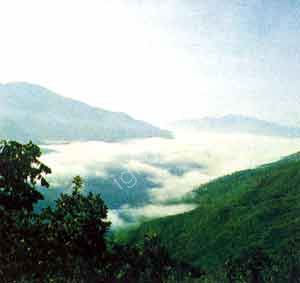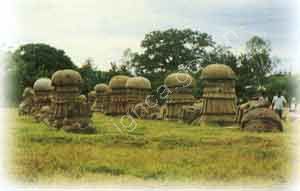Janapada Sampada
परिचय – नागालैंड
नागालैंड में मैदानी क्षेत्र में कुछ कुकी, कछारी, गारो, मिकरी,बंगाली, और असमिया आदि लोगों को छोड़ कर लगभग पूरी तरह से नागा जनजातियों का वास है। नागा शब्द के उद्गम के संबंध में विद्वानों द्वारा विभिन्न मत व्यक्त किए गए हैं। कुछ का मानना है कि नागा शब्द संस्कृत शब्द नग्न से विकसित हुआ है जिसका अर्थ है नंगा। ऐसा इसलिए है क्योंकि नागा लोगों को लोक-प्रसिद्ध रूप से उनके वस्त्रों के अभाव से जाना जाता है। एक और मत है कि नागा शब्द नाग से आया जिसका अर्थ है साँप अथवा साँपों का राजा। पौराणिक कथाओं के अनुसार राजकुमारी उलूपी एक नाग कन्या थी अर्थात साँपों के राजा की बेटी। उलूपी का निवास स्थान सामान्यत: नागालैंड के दक्षिण-पश्चिम में चिह्नित किया जाता है। चूंकि यह क्षेत्र नाग राज के अधीन था इसलिए यहाँ के लोगों को नागा के नाम से जाना जाता है |
मूल रूप से नागा लोगों को जनजातियों के नामों से नहीं जाना जाता था जैसा कि अब जाना जाता है बल्कि गांवों के समूह के नाम से जाना जाता था। धीरे-धीरे वे जनजातियों के नाम से जाने जाने लगे जैसा कि अब देखने को मिलता है, परंतु उनके मिलने अथवा अलग होने की प्रक्रिया अभी भी जारी है। जनगणना रिपोर्ट के अनुसार 16 नागा जनजातियाँ और चार गैर-नागा जनजातियाँ नागालैंड में निवास करती हैं। इन सोलह नागा जनजातियों में आओ, कोनयक, सेमा, चखेसंग, अंगमी, लोथा, संगतम, फोम, चांग, खेमूंगन, यीम्चूंगर, जेलंग, रेंगमा, तिखिर, मोकवरे, और चिर शामिल हैं। चार गैर-नागा जनजातियों में कुकी, कछारी, गारो, मिकीर शामिल हैं।
भूमि

नागालैंड एक पहाड़ी राज्य है। ये पहाड़ियाँ उत्तर में उप-हिमालयी श्रेणियों से जुडते हुए और मणिपुर की पहाड़ियों तक जाते हुए बर्मा आर्क का विस्तार है। यहाँ की भूमि के प्रमुख हिस्से में वन हैं और स्वाभाविक रूप से जंगलों में बहुत से पशु होते हैं। वास्तव में यहाँ बहुत सारे पक्षी तथा पशु और सरीसृप हैं। यहाँ पाए जाने वाले पक्षी हैं: सफ़ेद गिद्ध, काला तीतर, धूसर तीतर, सामान्य मोर, ब्ल्यू रॉक कबूतर, चितकबरा कबूतर,हुपु, मालाबार पाइड हॉर्नबिल, सामान्य बैबलर, महरत्ता कठफोड़वा, कोयल, चितकबरा उल्लू, ग्रेट होर्ण्ड उल्लू। पशुओं में सबसे अधिक पाए जाने वाले पशु हैं: जंगली सूअर, भौंकने वाला हिरण, हिमालयी काला हिरण, जंगली बकरी, जैकाल, जंगली बिल्ली, रॉयल बंगाल टाइगर, भेड़िया, तेंदुआ, जंगली कुत्ता, अजगर, बारहसिंगा, हाथी, भूमि कछुआ और अन्य सरीसृप।
इस स्थान के पहाड़ी होने और पहाड़ियों का विस्तार बहुत बड़ा न होने के कारण यहाँ बहुत कम नदियां हैं जो राज्य की सीमा तक चौड़ाई तथा लंबाई दोनों में काफी छोटी हैं। राज्य की कोई भी नदी किसी भी मौसम में नौगम्य नहीं है। शुष्क मौसम में ये लगभग पूरी तरह से सूख जाती हैं और वर्षा के मौसम में ये मूसलधार बन जाती हैं। इसके अतिरिक्त इस क्षेत्र की चट्टानी प्रकृति और गहरी घाटियों के कारण नौवहन संभव नहीं है। दिमापुर के मैदानों में कुछ छोटी नावें दिखाई देती हैं जिन्हें उँगलियों पर गिना जा सकता है। ये नौवहन के लिए नहीं हैं बल्कि स्थानीय रूप से मछली पकड़ने के लिए हैं। इन सभी नदियों में मछलियाँ उपलब्ध हैं।
झीलें और झरने नागालैंड में स्पष्ट रूप से अनुपस्थित हैं। ऐसे स्थान हैं जहां वर्षा के मौसम में पानी एकत्रित होता है और कम वर्षा के मौसम में सूख जाता है। नागालैंड में कोई झरना नहीं है, बेशक वर्षा के मौसम के दौरान विभिन्न छोटे झरने दिखाई देते हैं परंतु वे बहुत कम समय में सूख जाते हैं।
लोग:

नागा लोग साथ मिल कर रहने वाले लोग नहीं हैं। ये विभिन्न भाषाएँ बोलते हैं। ये परिधान तथा अन्य सांस्कृतिक विशेषताओं और शारीरिक संरचना में भी एक-दूसरे से बहुत भिन्न हैं। ये मंगोल जाति से आए हैं परंतु इसके बावजूद एक जनजाति और दूसरी जनजाति के बीच और एक ही जनजाति के विभिन्न लोगों के बीच विशेषताओं में अत्यधिक अंतर है। कुछ लंबे हैं तो कुछ नाटे हैं। कुछ लोगों का रंग पीला है और कुछ लोगों का रंग भूरा है। नागा लोगों की सांस्कृतिक परंपराओं में ऐसी विशेषताएँ शामिल हैं जो सभी जनजातियों में एक समान है जैसे शिकार करके सिर एकत्रित करना, अविवाहित पुरुषों के सोने के लिए एक घर जो महिलाओं के लिए निषिद्ध होता है, एक प्रकार का परीक्षण विवाह अथवा विवाह से पहले विपरीतलिंगियों के बीच शारीरिक संबंधों में अत्यधिक आजादी, मृत व्यक्ति का अंतिम संस्कार उठे हुए प्लेटफॉर्म पर करना, वस्त्रों की बुनाई के लिए सरल हथकरघा आदि।

नागा लोगों में अथवा गैर-नागा जनजातियों में कोई जाति प्रणाली नहीं है। परंतु प्रत्येक नागा जनजाति को विभिन्न अथवा बीस वंशों में विभाजित किया गया है। वंश प्रमुख रूप से पूर्वजों अथवा ऐसी अन्य चीजों पर आधारित होते हैं जिससे लोगों के एक समूह को दूसरे समूह से अलग पहचाना जा सके। जितनी बड़ी जनजाति होती है वंशों की संख्या उतनी अधिक होती है। हाल ही के समय में लगभग सभी जनजातियों के बीच एक प्रकार की गोत्र अथवा पारिवारिक वंशावली की प्रणाली शुरू हो गई है। यह उस परिवार के एक महत्वपूर्ण पुरुष से शुरू होती है जिसका नाम उसके वंशजों द्वारा उपनाम के रूप में प्रयोग किया जाता है। इसका वंश प्रणाली से कोई संबंध नहीं है, परंतु समय के साथ-साथ ऐसा पारिवारिक नाम एक वंश नाम बन सकता है। सामान्यत:एक ही वंश में विवाह निषिद्ध होता है परंतु आजकल युवा पुरुष एवं महिलाएं प्राय: इस प्रथा का उलंघन कर रहे हैं।


नागालैंड में जीवन पूरे वर्ष त्योहारों से भरा रहता है चूंकि सभी जनजातियों के अपने त्योहार हैं, जिनका वे बहुत आनंद उठाते हैं। ये अपने त्योहारों को पवित्र मानते हैं और इनमें भाग लेना अनिवार्य होता है। ये अपने विशिष्ट मौसमी त्योहार तड़क-भड़क, रंगों, संगीत तथा धूमधाम से मनाते हैं।इनमें से अधिकतर त्योहार कृषि पर आधारित हैं, जो अभी भी नागा समाज का प्रमुख कार्य है। नागालैंड की 85% से अधिक जनसंख्या प्रत्यक्ष रूप से कृषि पर निर्भर है। नागा लोग जंगली, खुले चारागाह वाले ग्रामीण क्षेत्रों में निवास करते हैं। इस आनंदमय वातावरण में नागा लोग दुर्लभ उत्साह के साथ प्रकृति के उपहार का आनंद लेते हैं जो देखने वालों को आश्चर्य तथा प्रशंसा की भावना से भर देता है।
यद्यपि कुछ धार्मिक और आध्यात्मिक भावनाएँ धर्मनिरपेक्ष रिवाजों तथा प्रथाओं में परस्पर घुली-मिली हुई हैं, फिर भी त्योहारों का प्रमुख विषय विभिन्न नागा बोलियों में विभिन्न नामों से पुकारे जाने वाले परमात्मा से प्रार्थना करना है। इन त्योहारों में फसल बोने से पहले अथवा फसल काटने से पहले भरपूर फसल के लिए गाँव के पुजारी द्वारा बलि दे कर आत्माओं और देवताओं को संतुष्ट किया जाता है। पूरे वर्ष नागालैंड के लोग त्योहार मनाते हैं। वे जनवरी में चखेसंग सुकृन्ये त्योहार से शुरुआत करते हैं, जिसके बाद फरवरी में कुकी मिमकूट;अंगमी सेक्रेनयी मनाया जाता है।अप्रैल का महीना पहले सप्ताह में कोनयक आओलिंग और फोम मोनयू त्योहारों के साथ शुरू होता है। आओ मोतसू और खियाम्निउंगन मिउ मई में मनाए जाते हैं;सुमी तुलूनी और चांग न्कन्युलूम त्योहार जुलाई के माह में मनाए जाते हैं। अगस्त और सितंबर माह में यीम्चूंगर मेटेम्नेओ और संगतम मोङ्ग्मोंग त्योहार मनाए जाते हैं। नवंबर माह में लोथा तोखू एमोङ्ग और रेंगमा नगाड़ा त्योहार मनाए जाते हैं। अंतिम महीने में जेलिंग ङ्गा-ङ्गई त्योहार पूरे उल्लास और धूमधाम से मनाया जाता है और इस त्योहार के साथ वर्ष समाप्त होता है और अगला वर्ष शुरू होता है।.

हाल ही के समय तक रहस्य में डूबे हुए और अत्यधिक अद्भुत नागालैंड के भूभाग का उल्लेख हाल ही के संस्कृत ग्रन्थों में मिलता है, जहां इसे ‘नाग भूमि’ कहा गया है – अर्थात साँपों की भूमि। इसकी स्थिति की दुर्गमता, दुर्गम भूक्षेत्र, और वन्य जीवों तथा वनस्पति के कारण नागालैंड लंबे समय तक यह एक अछूता क्षेत्र रहा – जहां बाहरी दुनिया के बहुत कम मनुष्यों ने कदम रखने का साहस किया। परंतु अब ऐसा नहीं है। बढ़ती जागरूकता और यात्रा तथा पर्यटन के क्षेत्र में रुचि के साथ उत्सुक यात्री लगातार नए गंतव्य तलाशते हैं। परिणामस्वरूप नागालैंड तेजी से एक विशिष्ट पर्यटन स्थल के रूप में उभर रहा है। नागालैंड में शांत प्राकृतिक सुंदरता और पहाड़ियों के मनोरम दृश्य दिखाई देते हैं जो वास्तव में विशाल हिमालय की पूर्वी शाखाएँ हैं।
हाल ही में नागालैंड के चार जिलों को अंतर्राष्ट्रीय पर्यटकों के लिए खोला गया है। ये हैं कोहिमा, दिमापुर, वोखा और मोकोकचुंग। कोहिमा राज्य की राजधानी है जो समुद्र तल से 1495 मीटर की ऊंचाई पर स्थित है। यह एक मनमोहक हिल स्टेशन है जो विशाल मनोरम दृश्य प्रस्तुत करता है। यहाँ का युद्ध समाधि स्थल द्वितीय विश्व युद्ध में प्राणों का बलिदान देने वाले अधिकारियों और सैनिकों के सम्मान में बनाया गया एक प्रतीकात्मक स्मारक है। यहाँ लिखे गए समाधि-लेख भावुक करने वाले हैं। नागालैंड में कुछ पर्वत और चोटियाँ हैं, जो देखने लायक हैं। जपफू चोटी, जो समुद्र तल से 3048 मीटर की ऊंचाई पर स्थित है, नागालैंड में माउंट सारामती के बाद दूसरी सबसे ऊंची चोटी है। इस चोटी से सूर्योदय को देखना यादगार अनुभव होता है। माउंट टेंपू एक अन्य चोटी है जो देखने लायक है। यह 3000 मीटर की ऊंचाई पर है। इस चोटी से आप जूकोई घाटी का दृश्य अपनी आँखों से देख सकते हैं। जूकोऊ घाटी समुद्र तल से 2433 मीटर की ऊंचाई पर स्थित है। यह युवा ट्रेकरों और ध्यान समूहों का पसंदीदा स्थान है। यहाँ कुछ गाँव हैं जो रुचिकर हो सकते हैं। खोनोमा गाँव को इसकी बहादुरी के लिए जाना जाता है चूंकि यहाँ के निवासियों ने अंग्रेजों के विरुद्ध एक घमासान युद्ध लड़ा था जो अक्तूबर 1879 में नागा पहाड़ियों पर कब्जा करने के अभियान पर आए थे। एक और महत्वपूर्ण गाँव है शंग्न्यू गाँव जिसे चीफटेन आंग द्वारा शासित किया जाता है। यह इस गाँव में स्थित लकड़ी के स्मारक के लिए प्रसिद्ध है जिसके बारे में माना जाता है कि यह दैवीय दूतों द्वारा बनाया गया था। एक अन्य स्थान जो रुचिकर हो सकता है वह इमपुर है। इस स्थान पर प्रारंभिक अमेरिकी बेपटिस्ट मिशनरियों ने एक मिशन केंद्र स्थापित किया था। यह मोकोकचुंग से 18 किमी. दूर है और यहाँ एक तीर्थ केंद्र स्थापित किया जाना प्रस्तावित है।




